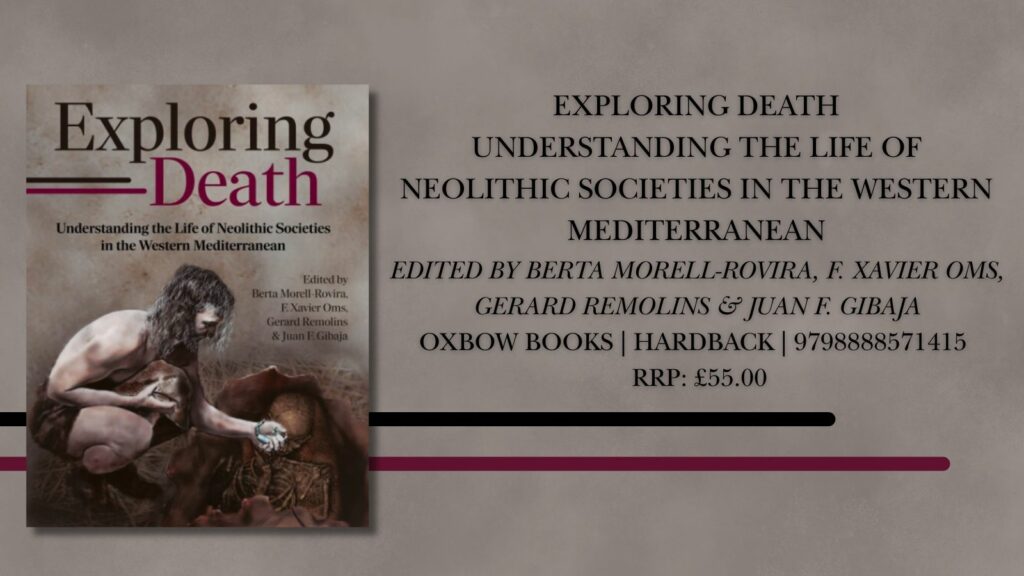Explore how the first farmers of the Mediterranean faced the eternal question of death, and how the study of funerary practices can reveal new ways of imagining life in the past with this blog by the editors of Exploring Death.
By Berta Morell-Rovira, F. Xavier Oms,
Gerard Remolins & Juan F. Gibaja | 3 min read
What can burials thousands of years old tell us about the lives of the first farming communities? And why should we still care today?
Our new volume, Exploring Death: Understanding the Life of Neolithic Societies in the Western Mediterranean, brings together research from across the western Mediterranean to shed new light on these questions. The Neolithic period, beginning in the sixth millennium BC, was a time of profound change. Farming spread, new forms of settlement emerged, and societies began to experiment with different ways of dealing with death.
Funerary contexts offer some of the most intimate glimpses into past lives. Through the study of human remains and mortuary rituals, we can explore not only diet, health, and mobility, but also the symbolic worlds that framed how people understood life and death.
A Diversity of Practices
One of the central themes running through the volume is diversity. There was no single “Neolithic way of death.” Across the Mediterranean, communities experimented with a wide range of practices: some favoured collective burials in caves, others invested in monumental tombs, cemeteries, while still others chose more ephemeral settings. These variations were far from random. They mirrored the diverse social and cultural dynamics of these groups, and the ways in which they imagined belonging, memory, and difference.
The contrast between individual and collective burial, for example, invites deeper questions: was identity expressed primarily through the community, or through the individual? How did gender, kinship, or age shape mortuary treatment? Each case study in the book opens a window onto these broader debates, highlighting the complex interplay between funerary practices and social life.
Diverse Methods, Deeper Insights
Another key thread of the volume is the diversity of analytical methods employed. Beyond traditional typology and chronology, contributors apply a wide range of approaches: bioarchaeological analyses such as stable isotopes, aDNA, and high-precision radiocarbon dating; studies of ceramics and their technological traditions; functional and use-wear analysis of lithic, macrolithic, and bone tools; examinations of faunal assemblages; as well as investigations of ornaments and different burial architectures. Together, these methods allow us to move from static categories to dynamic biographies—reconstructing where people grew up, what they ate, how mobile they were, the technologies they used, and how they related to one another.
Human stories
Funerary archaeology is also about stories. How should we interpret a shell ornament or a polished axe found with a burial? Such details are not trivial; they speak to values of memory, identity, and care for the dead. At the same time, they illuminate the broader social, economic, and cultural dynamics of these communities—how status was marked, how exchange networks operated, and how diversity was expressed in daily and ritual life. These are questions that resonate well beyond prehistory.
The Mediterranean offers a particularly rich stage for exploring these questions. It has always been both a crossroads and a mosaic, where communities interacted across seas and mountains. By comparing funerary practices from Spain, France, Switzerland, Portugal, Italy and beyond, the volume highlights both connections and contrasts. Were similar practices the result of shared ideas, long-distance contacts, or parallel solutions to common challenges? In every case, the ways in which the dead were treated reflect the diversity of the living societies that created these practices.
Why it matters
Why does any of this matter today? Because mortuary practices reflect values about the living as much as about the dead. They remind us that diversity has always been central to human societies. They also highlight the deep roots of questions that continue to shape us: identity, belonging, memory, and difference.
As editors, our aim with Exploring Death was not only to gather new research, but to foster dialogue across traditions and generations. The volume includes contributions from established researchers and early-career scholars, all bringing different perspectives to the table. Together, these perspectives underscore how the study of the ways in which past communities faced death ultimately deepens our understanding of life, society, and the enduring complexity of being human.
An Invitation
We hope that readers—archaeologists, historians, students, or anyone curious about the past—will find in this book both detailed insights and broader reflections. Funerary archaeology is, at its core, about understanding how communities constructed meaning through death. The Neolithic in the Western Mediterranean offers a powerful case study.
We invite you to join us in discovering how the first farmers of the Mediterranean faced the eternal question of death, and in doing so, revealed new ways of imagining life.
Exploring Death is now available through Script Archaeology.

Featured image credit: sandid from Pixabay

 Follow
Follow